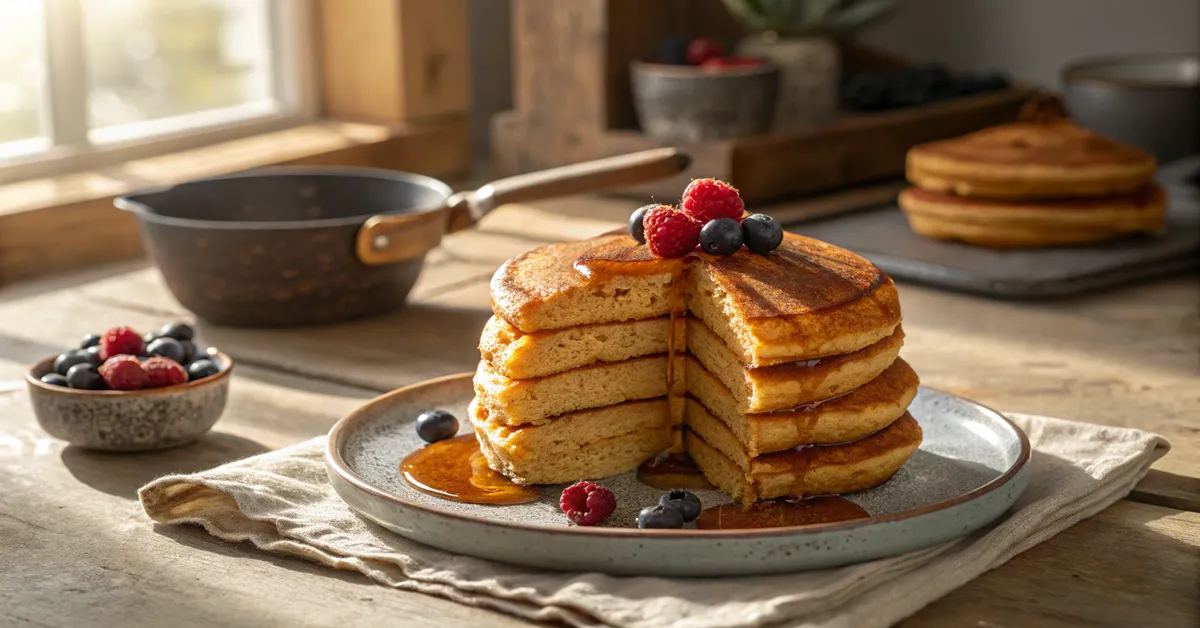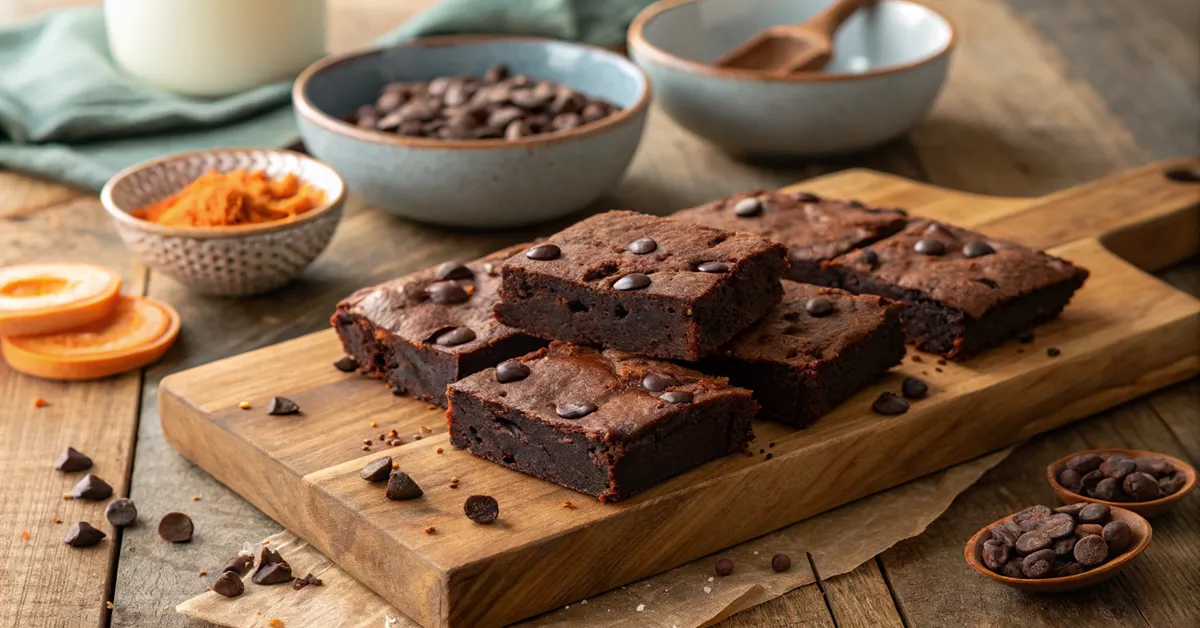Authentic Spaghetti Alla Chitarra: 7 Secrets From Abruzzo’s Kitchen
Have you ever had one of those food moments that just blows your mind? Mine happened last summer when I was wandering around this tiny village in Italy. I saw this grandmother making pasta in her kitchen window, but she wasn’t using a regular pasta machine. She had this wooden thing that looked exactly like a guitar, and she was pressing pasta dough through it to make these perfect square noodles.
I had to knock on her door to find out what she was doing. She laughed and said “spaghetti alla chitarra” – which basically means guitar pasta. After she let me try some, I understood why this pasta has been around for hundreds of years. The square shape makes such a huge difference. It holds onto sauce like crazy, and every bite has this amazing texture that regular round spaghetti just can’t match.
What Makes Spaghetti Alla Chitarra Special? Understanding Italy’s Square Pasta
The Square Shape That Changes Everything
Look, I’ll be honest with you – before I tried spaghetti alla chitarra, I thought pasta was pasta. Boy, was I wrong. The square shape isn’t just some fancy Italian thing to show off. This works far better than round pasta, and I’ll tell you why.
When you twirl spaghetti alla chitarra on your fork, those square edges grab onto sauce in a completely different way. I remember the first time I made it at home, I used my regular marinara sauce. I couldn’t believe how much more sauce stuck to each bite compared to regular spaghetti. It’s like the pasta was designed to hold onto every drop.
The texture is incredible too. Spaghetti alla chitarra has this satisfying chewiness that you just don’t get with store-bought pasta. It’s sturdy enough to handle chunky meat sauces but delicate enough for simple olive oil and garlic. Italian chefs swear by this stuff, and after making it myself, I totally get why. It’s perfect with Mediterranean flavors like the ones you’ll find in our Mediterranean chicken bowl recipes.
The Guitar Tool That Makes the Magic Happen
So about this chitarra tool – it really does look like someone took the strings off a guitar and stretched them over a wooden box. The Italian word “chitarra” literally means guitar, so they weren’t being creative with the name. They just called it what it looked like.
You roll your pasta dough over these steel wires, press down, and boom – perfect square spaghetti alla chitarra noodles drop through. It’s honestly pretty satisfying to watch. The wires are spaced just right to make noodles that aren’t too thick or too thin.But here’s the thing – you don’t absolutely need a chitarra to make spaghetti alla chitarra. I’ve made it with just a sharp knife, cutting the dough into thin strips and trying to keep them square. It takes longer and they’re not perfectly uniform, but they still taste amazing. Some people even use clean guitar strings (though I’ve never been brave enough to try that). The key is getting that square shape, however you manage it.
Table of Contents
Table of Contents
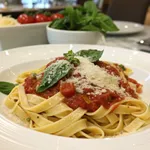
Authentic Spaghetti Alla Chitarra: 7 Secrets From Abruzzo’s Kitchen
- Total Time: 49 minutes
- Yield: 4 servings
Description
Spaghetti Alla Chitarra is a traditional pasta from Italy’s Abruzzo region, made using a guitar-like tool called chitarra. This authentic recipe creates sturdy, flavorful pasta perfect for holding robust sauces.
Ingredients
400g semolina flour – This is the biggie. Not all-purpose flour, not bread flour. Semolina. It’s coarser and gives spaghetti alla chitarra its signature texture.
4 large eggs – Room temperature works best. Cold eggs don’t mix as well with the flour.
2 tablespoons extra virgin olive oil (for best flavor, don’t use a cheap one)
1 teaspoon fine sea salt (this helps bring out the flavor of the pasta).
Instructions
Step1:Pour the semolina flour onto your counter, forming a pile. Push it around with your hands to make a well in the middle – like a volcano crater. Make the walls pretty high so your eggs won’t escape.
Step2:Crack all 4 eggs right into that flour crater. Add the olive oil and salt directly on top of the eggs. Don’t worry if it looks messy – that’s normal.
Step3:Grab a fork and start beating the eggs gently, right there in the flour well. As you beat, you’ll start pulling little bits of flour from the walls into the egg mixture. Keep doing this slowly.
Step4:Keep mixing for about 3-4 minutes until you have this shaggy, rough-looking dough. It’s not going to look pretty yet. Some flour might be dry still – that’s okay.
Step5:Start bringing it together with your hands. Scrape up any flour that isn’t mixed in and work it into the dough. You want all the flour incorporated, even if it feels a bit rough.
Step1:Begin kneading the dough by using the heel of your hand to push it away, then fold it back onto itself. Turn it a quarter turn and repeat. You’ll do this for about 8-10 minutes.
Step2:Keep kneading until smooth – At first it’ll feel rough, but gradually it becomes smooth and elastic. You’ll know it’s ready when you poke it with your finger and it springs back.
Step3:Wrap the dough tight in plastic wrap. This is super important – no air should get to it. Let it rest on your counter for at least 30 minutes. I usually go for 45 minutes because it makes rolling easier.
Step4:Roll the dough thin – Unwrap your dough and cut it into 4 pieces (easier to work with). Roll each piece with a rolling pin until it’s about as thick as a nickel – roughly 2mm thin.
Step5:Cut with your chitarra – Place the rolled dough on your chitarra tool and gently press it through the wires with your rolling pin. If you don’t have a chitarra, cut thin strips with a sharp knife, making them as square as possible.
Step6:Dust everything with semolina – As you cut each strand, toss it with a little semolina flour so they don’t stick together.
Step7:Let them dry slightly – Spread your spaghetti alla chitarra on a clean kitchen towel for about 10 minutes before cooking.
Notes
- Semolina flour is essential for proper texture
- Dough must rest minimum 30 minutes
- Can be frozen for up to 3 months
- Works with any sauce, especially meat-based ragùs
- Prep Time: 45 minutes
- Cook Time: 4 minutes
- Category: Mediterranean Dinner Recipes
- Method: Hand-rolled
- Cuisine: Mediterranean
Nutrition
- Serving Size: 1 cup (100g)
- Calories: 350 kcal
- Sugar: 2g
- Sodium: 200mg
- Fat: 3g
- Saturated Fat: 1g
- Unsaturated Fat: 2g
- Trans Fat: 0g
- Carbohydrates: 70g
- Fiber: 3g
- Protein: 12g
- Cholesterol: 95mg
Essential Ingredients for Perfect Spaghetti Alla Chitarra
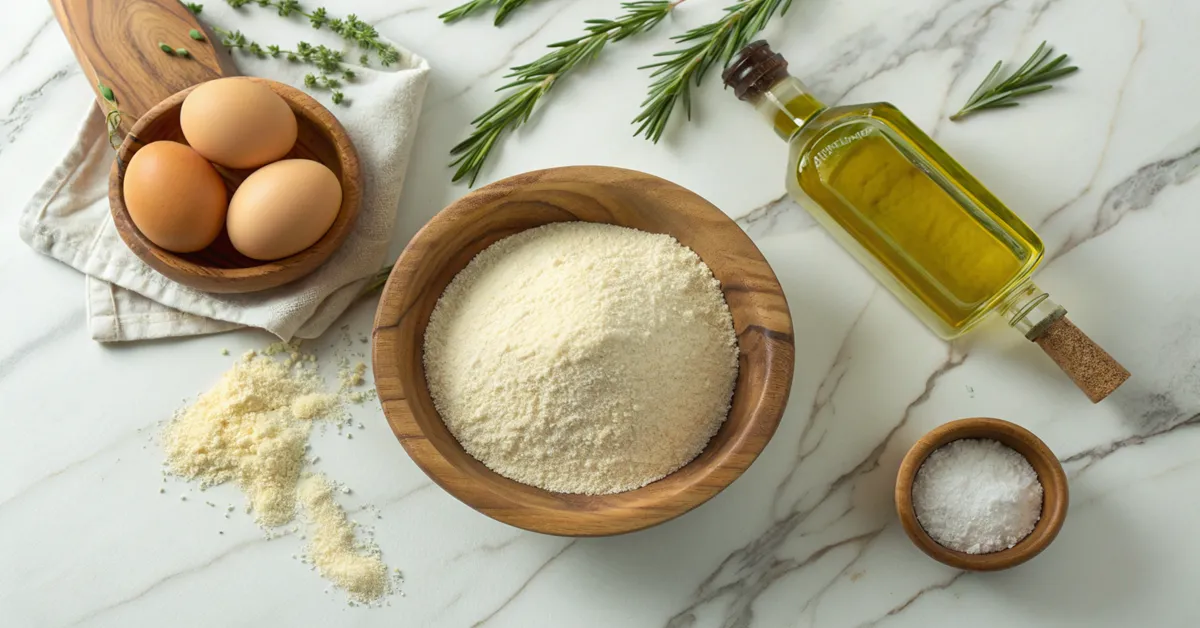
The Must-Have Ingredients (No Substitutions!)
Alright, let’s talk ingredients for spaghetti alla chitarra. I’m going to be straight with you – you can’t really mess around with this recipe. Some recipes are forgiving, but this isn’t one of them. Here’s exactly what you need:
The Essential Four:
- 400g semolina flour – This is the biggie. Not all-purpose flour, not bread flour. Semolina. It’s coarser and gives spaghetti alla chitarra its signature texture.
- 4 large eggs – Room temperature works best. Cold eggs don’t mix as well with the flour.
- 2 tablespoons extra virgin olive oil (for best flavor, don’t use a cheap one)
- 1 teaspoon fine sea salt (this helps bring out the flavor of the pasta).
That’s it. Four ingredients. But here’s what I learned the hard way – quality matters big time. The first time I made spaghetti alla chitarra, I used regular flour because that’s what I had. It was a disaster. The pasta fell apart in the water and had no character. Semolina flour is what makes this pasta special – it gives it structure and that slightly nutty flavor.
Why These Specific Ratios Work Every Time
The proportions for spaghetti alla chitarra aren’t random. Italian grandmothers have spent generations perfecting this, and they stick to about 100g of semolina per egg for a reason. If you use too much flour, your pasta will be tough as shoe leather. Too little and it falls apart when you cook it.
Room temperature eggs are a game-changer. I used to crack cold eggs straight from the fridge, which made the dough lumpy and difficult to work with. Now I take my eggs out about 30 minutes before I start cooking. They blend so much better with the semolina.
The olive oil isn’t just for flavor – it helps keep the dough pliable while you’re working with it. And that salt? Don’t skip it. It’s not just for the cooking water. Salt in the actual dough makes the spaghetti alla chitarra taste like something instead of just bland noodles. This pasta works beautifully with fresh Mediterranean ingredients like those in our tuna and white bean salad recipe.
Step-by-Step Instructions: Mastering the Ancient Technique
Making the Perfect Dough From Simple Ingredients
Okay, so making spaghetti alla chitarra dough is way easier than you think. I’m going to walk you through it step by step, just like that Italian grandma taught me.
First, clear off your kitchen counter and make sure it’s clean. Now here’s what you do:
- Pour the semolina flour onto your counter, forming a pile. Push it around with your hands to make a well in the middle – like a volcano crater. Make the walls pretty high so your eggs won’t escape.
- Crack all 4 eggs right into that flour crater. Add the olive oil and salt directly on top of the eggs. Don’t worry if it looks messy – that’s normal.
- Grab a fork and start beating the eggs gently, right there in the flour well. As you beat, you’ll start pulling little bits of flour from the walls into the egg mixture. Keep doing this slowly.
- Keep mixing for about 3-4 minutes until you have this shaggy, rough-looking dough. It’s not going to look pretty yet. Some flour might be dry still – that’s okay.
- Start bringing it together with your hands. Scrape up any flour that isn’t mixed in and work it into the dough. You want all the flour incorporated, even if it feels a bit rough.
The biggest mistake I made when I first tried this was rushing. Take your time with this part. The dough should feel slightly rough and maybe even a little dry. That’s exactly what you want for spaghetti alla chitarra.
Kneading, Resting, and Cutting Your Perfect Square Pasta
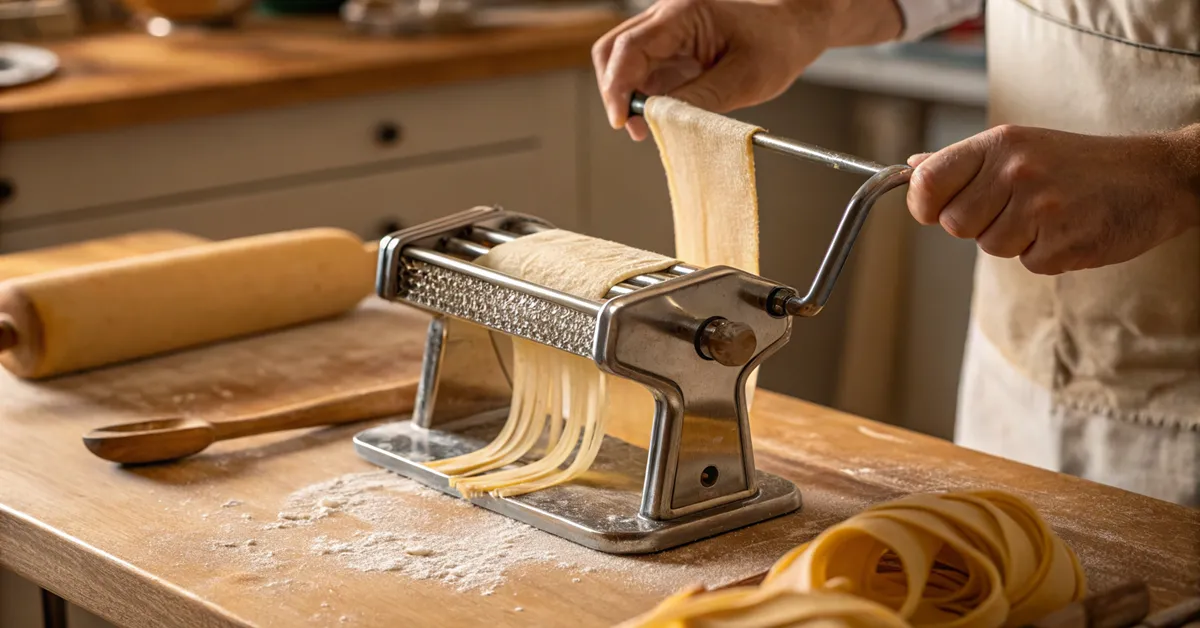
Now comes the fun part – turning that rough dough into silky, smooth pasta dough. This is where spaghetti alla chitarra really starts to come together.
- Begin kneading the dough by using the heel of your hand to push it away, then fold it back onto itself. Turn it a quarter turn and repeat. You’ll do this for about 8-10 minutes.
- Keep kneading until smooth – At first it’ll feel rough, but gradually it becomes smooth and elastic. You’ll know it’s ready when you poke it with your finger and it springs back.
- Wrap the dough tight in plastic wrap. This is super important – no air should get to it. Let it rest on your counter for at least 30 minutes. I usually go for 45 minutes because it makes rolling easier.
- Roll the dough thin – Unwrap your dough and cut it into 4 pieces (easier to work with). Roll each piece with a rolling pin until it’s about as thick as a nickel – roughly 2mm thin.
- Cut with your chitarra – Place the rolled dough on your chitarra tool and gently press it through the wires with your rolling pin. If you don’t have a chitarra, cut thin strips with a sharp knife, making them as square as possible.
- Dust everything with semolina – As you cut each strand, toss it with a little semolina flour so they don’t stick together.
- Let them dry slightly – Spread your spaghetti alla chitarra on a clean kitchen towel for about 10 minutes before cooking.
I cannot stress enough how important that resting time is. The first time I made spaghetti alla chitarra, I skipped this step because I was hungry. The dough was impossible to roll, and I ended up with thick, chewy noodles. Learn from my mistake! This technique works beautifully with fresh ingredients like those in our stuffed eggplant recipe.
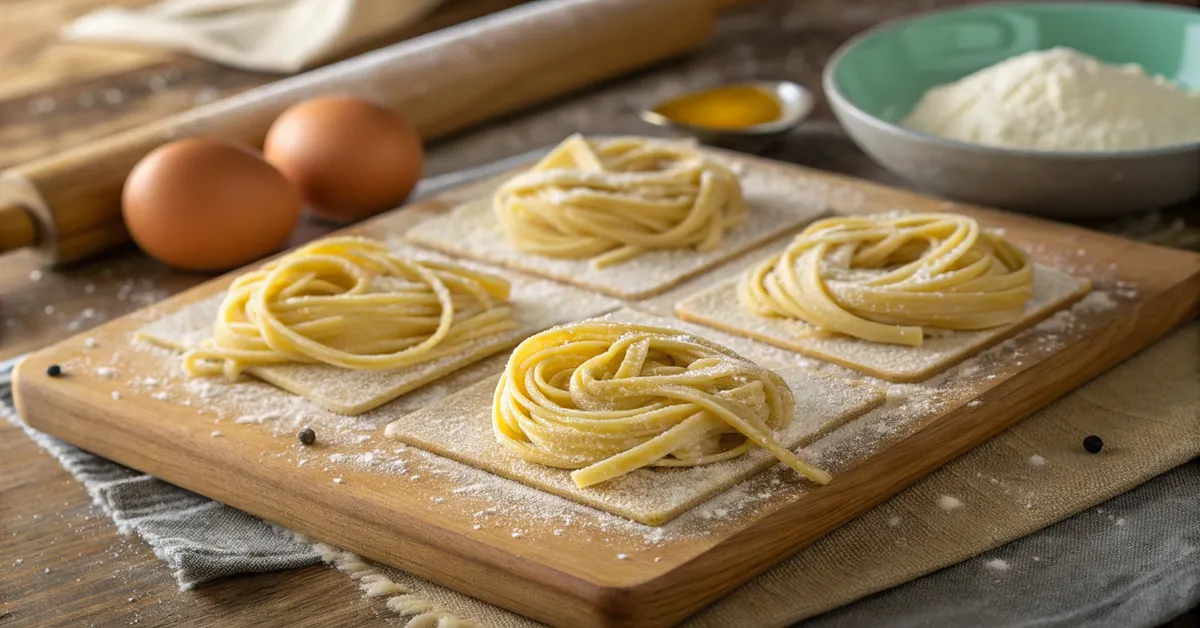
Customization & Variations: Making It Your Own
Traditional Sauce Pairings That Work Best
Spaghetti alla chitarra is incredibly versatile, but some sauces just work better than others. In Abruzzo, they traditionally serve it with lamb ragu or simple tomato sauce. The square shape holds chunky sauces really well.
My favorite pairings for spaghetti alla chitarra:
- Simple marinara – lets the pasta texture shine
- A mushroom and herb sauce is a great choice because its earthy flavors really complement the semolina
- Vegetable ragu – perfect for a lighter meal
- Olive oil and garlic – classic and foolproof
The beauty of spaghetti alla chitarra is that it doesn’t get overwhelmed by bold flavors. I’ve served it with everything from pesto to meat sauce, and it always delivers. For Mediterranean-inspired meals, try pairing it with components from our Mediterranean salmon bowl guide.
Modern Twists on the Classic Recipe
Feel free to experiment with your spaghetti alla chitarra. I’ve added spinach to the dough for color and extra nutrition. You can also substitute half the semolina with whole wheat flour for more fiber, though it changes the texture slightly.
Some variations I’ve tried:
- To make it herb-infused, add dried basil or oregano to the dough
- Lemon zest – brightens the flavor beautifully
- Half whole wheat – for a nuttier taste
- Egg yolk only – creates richer, more golden spaghetti alla chitarra
Just remember not to stray too far from the basic recipe. The combination of semolina and eggs is what makes spaghetti alla chitarra so special.. These variations work great with fresh ingredients like those in our chimichurri hummus for a complete Mediterranean meal.
Storage & Meal Prep Tips: Planning Ahead Like a Pro
Smart Storage Tips for Fresh Pasta
Let me tell you about storage, because I learned this lesson the hard way. Fresh spaghetti alla chitarra is nothing like the dried stuff you buy at the store. It doesn’t keep nearly as long, but there are some tricks to make it last.
If you’re planning to use your spaghetti alla chitarra within a couple of days, you can store it in the fridge. Just dust it really well with semolina flour – I mean really well – and put it in an airtight container. It’ll keep for about 2-3 days max. Any longer and it starts getting slimy.
For longer storage, freezing is your best bet. Here’s what I do: after I cut the spaghetti alla chitarra, I lay it out on baking sheets lined with parchment paper. I stick the whole tray in the freezer for about an hour until the noodles are frozen solid. Then I transfer them to freezer bags. This way, they don’t clump together into one big frozen mess.
| Storage Method | How Long It Lasts | What I Use It For |
| Counter | 2 hours tops | When I’m cooking right away |
| Fridge | 2-3 days | Short-term storage |
| Freezer | Up to 3 months | Meal prep batches |
| Air-dried | 2 weeks | When I want shelf-stable pasta |
Meal Prep That Actually Works
I’ve gotten pretty good at meal prepping with spaghetti alla chitarra, and I’ll share what actually works. The trick is not to fully cook the pasta when you’re prepping. Cook it until it’s just shy of al dente – like 30 seconds less than you normally would. Then when you reheat it with your sauce, it finishes cooking perfectly.
This technique is called mantecatura in Italian, and it’s a game-changer. The pasta absorbs flavor from the sauce while it finishes cooking, so you get way better results than just reheating fully cooked pasta.You can also prep all your components separately. Make a big batch of spaghetti alla chitarra on Sunday, portion it out, and freeze it. Make your sauces separately and store them in the fridge. Then during the week, you just boil some water, cook the frozen pasta (straight from the freezer – no thawing needed), and toss with your sauce. Pairs perfectly with make-ahead components from our couscous and quinoa salad for complete Mediterranean meals.
Nutrition Information: Understanding the Benefits
Why Homemade Pasta is Actually Good for You
Look, I’m not going to pretend that spaghetti alla chitarra is health food, but when you make it at home, you’re definitely getting some benefits. First off, you know exactly what ingredients you’re using. No weird preservatives or chemicals – just flour, eggs, oil, and salt.
Semolina flour is actually better for you than regular white flour in several ways. It has more protein, more fiber, and more minerals like iron and B vitamins. When I make spaghetti alla chitarra at home, I feel better about serving it to my family because I know it’s real food.
The eggs add high-quality complete proteins – the kind your body can actually use efficiently. Plus, when you make pasta fresh, it’s more satisfying than the dried stuff, so you tend to eat smaller portions while feeling more full.
| What You Get | Per 100g Serving | Why It Matters |
| Calories | 350 | Sustained energy from complex carbs |
| Protein | 12g | More than regular pasta |
| Carbs | 70g | The good kind – complex carbohydrates |
| Fat | 3g | Mostly from eggs and olive oil |
| Fiber | 3g | Helps with digestion |
| Iron | 2mg | Important for energy levels |
How It Stacks Up Against Store-Bought Pasta
The difference between homemade spaghetti alla chitarra and the stuff you buy at the store is pretty dramatic when you look at nutrition. Store-bought pasta often has preservatives, higher sodium, and way less protein.
| What’s Different | Homemade | Store-Bought |
| Protein content | 12g per serving | Usually around 8g |
| Preservatives | Zero | Usually several |
| Sodium | You control it | Often loaded with salt |
| Texture | Firm, satisfying bite | Can get mushy |
| Flavor | Rich, complex | Pretty one-dimensional |
| Satisfaction | Keeps you full longer | You want more sooner |
When you make spaghetti alla chitarra at home, you’re getting maximum nutrition and flavor in every bite. It’s also more filling, so you naturally eat less while feeling more satisfied. This makes it a great foundation for healthy Mediterranean-style meals that incorporate fresh vegetables and lean proteins like those featured in our Mediterranean shrimp bowl recipes.
FAQ Section: Your Questions Answered
What is the difference between spaghetti and spaghetti alla chitarra?
The main difference is the shape. Regular spaghetti is round, but spaghetti alla chitarra has a square cross-section. This square shape holds sauce better and gives a different texture when you bite into it. With their square edges, the noodles have more surface area for the sauce to cling to.
What are spaghetti alla chitarra?
Spaghetti alla chitarra are traditional Italian pasta noodles from the Abruzzo region. They’re made by pressing pasta dough through a tool called a chitarra (which looks like a guitar) to create square-shaped strands instead of round ones.
What does alla chitarra mean?
“Alla chitarra” literally means “guitar style” in Italian. It refers to the special tool used to cut this pasta, which has parallel steel wires that look like guitar strings.
What is a chitarra made of?
A traditional chitarra is made of wood with steel wires stretched across it, just like a guitar. The spacing between the wires determines the thickness of your spaghetti alla chitarra.
What does the word chitarra mean in Italian?
“Chitarra” is simply the Italian word for “guitar.” The pasta-making tool got this name because it looks so much like the musical instrument.
Does spaghetti alla chitarra have meat?
No, spaghetti alla chitarra pasta itself doesn’t contain meat – it’s made with flour, eggs, and oil. However, it’s traditionally served with meat sauces, especially lamb ragu in its home region of Abruzzo.
Share Your Pasta Journey: Join Our Community
Tell Us About Your Spaghetti Alla Chitarra Adventures
Let me know how your spaghetti alla chitarra turns out! Did you use a traditional chitarra or get creative with your cutting method? What’s your favorite sauce pairing? Drop a comment below and share your experience – I read every single one.
There’s always something new to learn from fellow pasta lovers. Maybe you discovered a trick that makes the process easier, or perhaps you created an amazing new sauce combination. The beauty of spaghetti alla chitarra is that while the technique is traditional, there’s plenty of room for creativity.
Explore More Authentic Mediterranean Flavors
Ready to expand your Mediterranean cooking repertoire? Check out our collection of gluten-free Mediterranean recipes for more inspiration, or try our Italian lemon cake recipe for the perfect ending to your Italian dinner.
Remember, the real joy of cooking is creating memories and sharing traditions, not just feeding people. Every time you make spaghetti alla chitarra, you’re participating in a culinary tradition that goes back generations. That’s pretty special, don’t you think?
Final Thoughts: Bringing a Little Italy to Your Kitchen
Making spaghetti alla chitarra at home is one of those cooking experiences that just feels good, you know? There’s something really satisfying about creating these perfect square noodles with your own hands. Sure, it takes some practice to get the hang of it, but even when my first attempts weren’t perfect, they still tasted incredible.
Every time I make spaghetti alla chitarra, I think about that sweet Italian grandmother who first showed me how it’s done. She didn’t speak much English, and my Italian is terrible, but we understood each other perfectly in that kitchen. That’s what I love about cooking – it brings people together, even across language barriers.
The square shape really does make a difference. It’s not just some fancy Italian tradition for show. Your sauces cling better, the texture is more satisfying, and honestly, it just looks impressive when you serve it to people. Even if you don’t have that traditional chitarra tool, you can still make amazing spaghetti alla chitarra with just a sharp knife and some patience.
What strikes me most about this pasta is how it connects you to history. Every time you make spaghetti alla chitarra, you’re doing something that Italian families have been doing for hundreds of years. In our fast-paced world, there’s something truly grounding about that process..


